HISTORIA VEXILOLÓGICA DE VENEZUELA
Por RAÚL JESÚS ORTA PARDO / Simbólogo
La Historia Vexilológica de Venezuela podría dividirse en tres etapas:
- Era Colonial
Fue enarbolada en la revuelta pro-autonómica dirigida por Juan Francisco de
León (hacendado canario que vivió en la Venezuela Colonial) y por
desconocerse su diseño, se representa con un paño blanco con un signo de
interrogación entre paréntesis adaptando a la Vexilología el recurso
heráldico aplicado a los Escudos de Armas cuya existencia se conoce pero no
así sus emblemas y esmaltes.
Se describe en una carta cuya letra se supone pertenece a Juan Bautista
Picornell: uno de los conjurados en la conspiración de Gual y España contra
el régimen colonial imperante. Sus colores tienen un triple significado: las
etnias india, parda, blanca y negra; las provincias de Caracas, Maracaibo,
Cumaná y Guayana y los fundamentos revolucionarios de Igualdad, Libertad,
Propiedad y Seguridad.
Probablemente derivado de la anterior, se describe en una carta de Manuel
Gual capturado por los realistas luego de develar la conspiración que
dirigía junto a José María España y Juan
Picornell. El sol simboliza la Patria y la Igualdad que como ley debe ser
una para todos; las estrellas representan las provincias de Caracas,
Cumaná, Guayana y Maracaibo, y las franjas aluden a la unión íntima de las
etnias por la gran causa de la emancipación.
El Precursor de la Independencia Hispanoamericana realizó este proyecto
actualmente registrado en el Catálogo de Documentos del Archivo General de
Indias en Sevilla, España. Por coincidencia, es similar a la actual Bandera
Civil de la República Federal Alemana. Sus colores representan a las etnias
negra, parda e india, respectivamente, unidas luchando en pro de la
Independencia de Venezuela.
Concebida por Francisco de Miranda, fue afirmada en la Corbeta Leander el 12
de Marzo de 1806 en la Bahía de Jacmel, Haití e izada posteriormente en
tierra venezolana el 3 de Agosto de ese año. Aunque existen diversas
conjeturas acerca de su origen, la hipótesis predominante es que Miranda
tomó como modelo los colores primarios del Arco-Iris. Se presume que su
síntesis semiológica fue "Libertad, Patria, Carasioli" entendiéndose esta
última palabra como "Carior" para completar así su significado con esta
frase "La Patria es más preciada que la Libertad".
Fue resultado de una Comisión designada al efecto por el Congreso
Constituyente que declaro nuestra independencia bajo el nombre de
Confederación Americana de Venezuela, en la que además de Miranda figuraban
dos diputados más: Lino de Clemente y José de Sata y Bussy. Su vexilografía
se caracteriza por la desigualdad de sus franjas y el emblema en el cantón
cuya figura principal es una India que sujeta una lanza coronada por un
gorro frigio. Se presume que su significado es este "Las doradas tierras de
América, separadas por la Mar Océano del sanguinario imperio español" y se
le conoce como "Bandera Madre" pues de ella nacieron además las actuales
Banderas de las Repúblicas de Colombia y del Ecuador.
Es la misma Bandera de 1811 omitiendo el emblema del cantón por causa del
desarrollo mismo de la Guerra de Independencia.
El Congreso Provisional reunido en Pampatar (localidad de la Isla de
Margarita al este de Venezuela) establece que para uso de la Armada (Marina
de Guerra) se agregarán siete estrellas azules a la franja amarilla de la
Bandera de Armas en Tierra para recordar las Provincias que
fundaron Venezuela en 1811.
Angostura, ciudad al Sur-Este de Venezuela, es capturada por los Patriotas y
para registrar su anexión a la Causa de la Independencia El Libertador Simón
Bolivar (el más grande Héroe Venezolano y Padre de la Patria) decreta que la
Insignia Naval recién
establecida en Pampatar llevará en lo sucesivo ocho estrellas azules.
Decretada por el Congreso General de Cúcuta, combina la Bandera de Venezuela
y el Escudo de Armas de la República de Nueva Granada (actual República de
Colombia).
Establecida poco tiempo después de la anterior, sustituye el Escudo de Armas
de Nueva Granada por el de la Gran Colombia.
Consistió en la Bandera de 1811 en cuyo centro aparecía un Escudo de Armas
derivado del Grancolombiano en el que las cornucopias quedaban volcando sus
frutos hacia la punta completándose con la inscripción "ESTADO DE VENEZUELA"
en unas ocasiones y en otras, la de "REPÚBLICA DE VENEZUELA"
Decretada por el Congreso Nacional, consistió en franjas iguales y
horizontales con los colores amarillo, azul y rojo en este orden de arriba
hacia abajo. Se estableció además la distinción de carácter de la Bandera
Nacional pues se determinó que para uso oficial llevaría también el Escudo
de Armas de la República y por consiguiente desde entonces podemos afirmar
la existencia tradicional de la Bandera Nacional de Estado y la Bandera
Nacional Civil aunque su uso fuera indistinto. Sin embargo, nuestras
recientes investigaciones hacen presumir que Venezuela es la primera Nación
Soberana del Planeta que diferenció su Bandera Civil y su Bandera de
Estado/Guerra colocándole el Escudo de Armas de la República sobre el
cantón a ésta última.
La Junta de Gobierno Provisional establecido en Coro, ciudad al Noroeste de
Venezuela y actual capital del estado Falcón, se extralimita en sus
presuntas facultades y decreta que la Bandera de la Federación Venezolana
sería la misma de 1836 pero con inclusión de siete estrellas azules en la
franja amarilla en memoria de las Provincias que fundaron la Nación en 1811.
- Bandera de la Federación, Junio 1859
Triunfante en Barinas, región al Suroeste de Venezuela, el General Ezequiel
Zamora (uno de los líderes del bando federal) comete otro exceso decretando
que en lo sucesivo el Pabellón de los Estados Federales llevaría veinte
estrellas azules: una por cada estado que conformaría la Federación
Venezolana. A estas alturas parece claro el objeto práctico de esta Bandera
y su predecesora: diferenciarse de aquella que identificaba las tropas del
Gobierno que llevaba o no escudo y carecía de estrellas.
El Mariscal Juan Crisóstomo Falcón, en ejercicio de la Presidencia de la
República, emite un decreto firmado por todos sus ministros en el que
establece que la Bandera Nacional sería amarilla, azul y roja en franjas
iguales y horizontales con siete estrellas blancas de cinco puntas al centro
de la franja azul: seis en hexágono y la séptima en medio, reservándose la
adición del Escudo Nacional sólo a la de Uso Oficial.
El Presidente de la República, General Cipriano Castro, decreta que la
Bandera Nacional llevaría las estrellas en circunferencia, manteniendo su
distinción de carácter.
Establecida el 15 de Julio por disposición del Congreso Nacional (como debe
ser), incorpora la Constelación de Estrellas en arco de círculo con la
convexidad hacia arriba, tal vez, como reminiscencia de la cimera que hasta
ese año enriquecía algunas reproducciones del Escudo de Armas de la
República. Aún se mantiene vigente en dos variantes: la de Uso Civil con sus
tres colores y siete estrellas y la de Uso de Estado, que añade el Escudo de
Armas de la República con todos sus colores en el cantón. Sin embargo, la
Ley de Bandera, Escudo e Himno Nacionales vigente desde 1954 establece de
hecho tres Banderas: la Tricolor sin estrellas y sin Escudo, de Uso Civil;
la Tricolor con estrellas y con Escudo, de Uso de Estado y de Guerra y la de
la Marina Mercante, que sólo llevaría estrellas y que el Alma Venezolana
hizo suya en la práctica para empleo Civil haciendo impensable la ausencia
de sus estrellas.
It was hoisted in the pro-autonomic revolt leaded by Juan Francisco de Leon
( A Canary landowner who lived in Colonial Venezuela) and because is not
know its design, is represented by means of white field with a question mark
between parenthesis adapting to Vexillology the Heraldic resource applied to
Coat of Arms whose existence knows but not thus its enamels and emblems.
It's described in a letter whose letter supposed belongs to Juan Bautista
Picornell: one of promoters of the conspiracy of Gual y España against the
ruling colonial regime. Its colors have triple meaning: the ethnic groups
Indian, Brown (Creole), White and Black; the provinces of Caracas,
Maracaibo, Cumaná and Guayana and the revolutionary principles of Equality,
Freedom, Property and Security.
Probably derived from the previous one, it was described in a letter of
Manuel Gual captured by the royalist after frustrate the conspiracy which
leaded jointly with Jose Maria España and Juan Picornell. The sun symbolizes
the Homeland and the Equality which as Law must be one for everyone; the
stars represent the provinces of Caracas, Cumaná, Guayana and Maracaibo, and
the stripes alludes to the intimate union of the ethnic groups for the great
cause of emancipation.
The Precursor of the Hispanic-American Independence realized this project
currently recorded into Document Catalogue of the General Archives of Indias
in Seville, Spain. By coincidence, is similar to the current Civil Flag of
German Federal Republic. Its colors represent the ethnic groups Black, Brown
(Creole) and Indian, respectively, fighting united for the Independence of
Venezuela.
Conceived by Francisco de Miranda, it was affirmed on the Corvette "Leander"
on March 12th , 1806 in Jacmel Bay, Haiti and hoisted later in Venezuelan
ground August 3rd, that year. Although diverse conjectures exist about its
origin, the predominant hypothesis is that Miranda took as model the primary
colors from the rainbow. It 's presumed that its semiologic synthesis was
"Liberty, Homeland, Carasioli " being understood this last word like" Carior
" for complete its meaning with this phrase "Homeland is more appraised that
the Freedom ".
It was been product of Commission appointed to the effects by the
Constituent Congress which declared the national independence under the name
of American Confederation of Venezuela, which in addition to Miranda was
conformed with two deputies more: Lino de Clemente and José de Sata y Bussy.
Its vexillography its characterized by the un-equality of the stripes and
the emblem on the canton whose main figure is an Indian female subjecting a
lance crowned by a Phrygian or Liberty Cap. It presumed meaning is "The
golden territories of America separated by the Sea-Ocean of the bloodthirsty
Spanish empire" and is known as "Mother Flag" because from it were born in
addition the Flags of current Republics of Colombia and Ecuador.
Is the same Flag of 1811 omitting the emblem on the canton as a result of
the same development of Venezuelan War of Independence.
The Provisional Congress established on Pampatar (locality of Margarita
Island in the East of Venezuela) decreed that for use of the Navy would be
add seven blue stars on the yellow stripe of Flag of Liberator Army for
remember the Provinces which founded Venezuela on 1811.
Angostura, city located on Southeast of Venezuela, was captured by Patriotic
Forces and for register it annexation to the Cause of Independence El
Libertador Simón Bolívar (Venezuelan greatest hero and Father of the
Homeland) decrees that the Naval Ensign recently established on Pampatar
will shows in successive eight blue stars.
Decreed by the General Congress of
Cùcuta, combines the Venezuelan Flag and the Coat of Arms of Republic of New
Granada (today Republic of Colombia)
Established just short time after the previous one, replace the CoA of New
Granada by the one of Great Colombia.
It consisted of 1811' Venezuelan Flag in whose center appeared a Coat of
Arms derived from the Great-Columbian one in which cornucopias were
overturning their fruits towards the base completed with the inscription
"ESTADO DE VENEZUELA" (STATE OF VENEZUELA) in occasions and others, the one
of "REPÚBLICA DE VENEZUELA "(REPUBLIC OF VENEZUELA).
Decreed by National Congress, it consisted on three equal and horizontal
stripes with colors yellow, blue and red in this order from top to bottom..
Besides was established the character distinction of National Flag because
is was determinate that for official use it would bear also the Coat of Arms
of the Republic and therefore since then we can affirm the traditional
existence of the State National Flag and the Civil National Flag although
its use were indistinct. However, our recent investigations made presume
that Venezuela is the first Sovereign Nation of the Planet which
differenced its Civil and State/War Flags fixing the Coat of Arms of the
Republic on the canton of this last one.
The Provisional Government Council established on Coro, city of Northwest of
Venezuela and present capital of the Falcon State, is gone too far in its
presumed faculties and decrees that the Flag of Venezuelan Federation would
be the same one of 1836 but with inclusion of seven five pointed and blue
stars on the yellow stripe in memory of the Provinces that founded the
Nation on 1811.
Triumphant in Barinas, region on the Southwest of Venezuela, General
Ezequiel Zamora (one of the leaders of Federal Party) commits another excess
decreeing that in successive the so called Federal States' Pavilion would
bears twenty five pointed and blue stars: one by each state that would
conform the Venezuelan Federation. At this point the practical object of
this Flag and its antecedent seems clear: to be different itself from which
one identified Government's troops which bears or not Coat of Arms and lack
stars.
Field Marshall Juan Crisóstomo Falcon, exercising Presidency of the
Republic, emits a decree signed by all his ministers in which he establishes
that National Flag would be yellow, blue and red in equal and horizontal
stripes with seven five pointed and white stars disposed on the center of
the blue stripe: six in hexagon and seventh in the middle, reserving the
addition of the National Coat of Arms only for the flag with Official use.
President of the Republic, General Cipriano Castro, decrees that National
Flag would bear stars in circumference, maintaining its distinction of
character.
Established on July 15th by disposition of the National Congress (as it must
be), it incorporates the constellation of stars in arc of circle with
convexity upwards, perhaps, as remembrance of the crest that until that year
enriched some reproductions of Coat of Arms of the Republic. Still is
effective into two variants: one for Civil Use with its three colors and
seven stars and the one of State Use, that adds the Venezuelan Coat of Arms
in full color on the canton. Nevertheless, the Law of National Flag, Coat of
Arms and Anthem effective since 1954 establishes in fact three Venezuelan
flags: Tricolor without Stars and CoA, for Civil Use; Tricolor with Stars
and CoA, for State and War use and the one of the Merchant Marine, which
would only bears Stars and that Venezuelan Soul did hers for Civil Use too
making unthinkable actually the absence of its Stars.
- Era Independentista
- Era republicana
- Era Colonial (1498-1821)
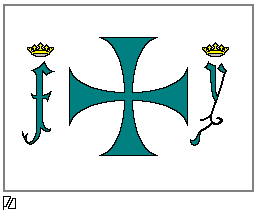
- Pendón de los Reyes Católicos - 1492
Consta de un campo blanco cargado con una cruz patee verde acompañada a
diestra y siniestra con las cifras o siglas de los Reyes Católicos Fernando
e Isabel en el mismo color y coronadas de oro. Fue uno de los emblemas que
Colón trajo a América y muy probablemente estuvo presente cuando avistó las
costas de la Península de Paría (actualmente ubicada al Oriente de
Venezuela) , como parte de su Tercer Viaje.
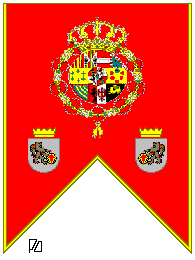
- Pendón Real de Carlos III en la Municipalidad de Caracas - 1725?
Consta de un contorno cola de milano de orientación vertical cuyo campo rojo
muestra las Armas Reales en la parte superior y las de Caracas, repetidas y
afrontadas al inicio de las farpas, todo enriquecido con un galón de
pasamanería en flequillo dorado. La imagen es reconstrucción del original
que actualmente se exhibe en el Museo Caracas del Municipio Libertador.
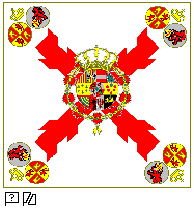
- Batallón Veteranos de Caracas - 1790 / 1821?
Consistía en un paño blanco con el Escudo Real superpuesto al centro de una
cruz de Borgoña con las Armas de Castilla y León acoladas o juntadas con las
de Caracas en los ángulos. La imagen es una reconstrucción realizada a
partir de una fuente escrita digna de crédito.
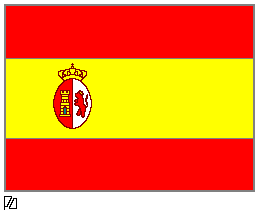
- Insignia Naval Española - 1798
Consiste en un paño terciado horizontal desigual cuyas franjas superior
e inferior son rojas y la central amarilla con una anchura equivalente
al doble de las anteriores: diseño decretado por el rey Carlos III en 1785 y
que se consolidó como Bandera Nacional Española en 1843. La ilustración es
reconstrucción de una de sus etapas evolutivas: en este caso, lleva las
Armas de Castilla y León coronadas y descentradas al asta en la faja
amarilla.
Era Independentista (1749 - 1830)
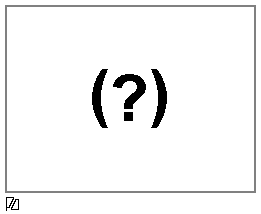
- Bandera Incógnita de Juan Francisco de León - 1749
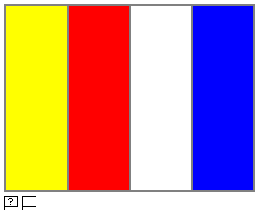
- Proyecto de Bandera de Juan Bautista Picornell - 1797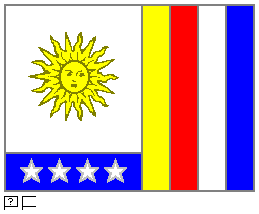
- Proyecto de Bandera de Gual y España - 1797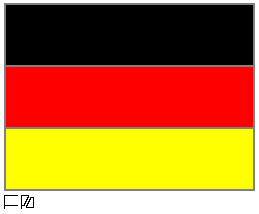
- Proyecto de Bandera de Francisco de Miranda - 1800
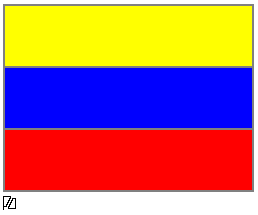
- Bandera Primada de Venezuela - 1806

- Bandera Madre - 1811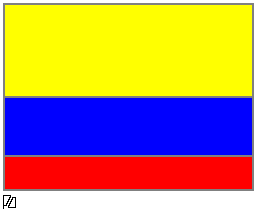
- Bandera del Ejército Libertador - 1811 / 1819
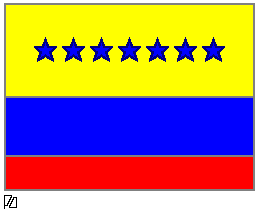
- Insignia Naval - Mayo 1817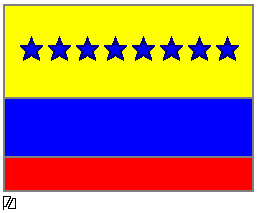
- Bandera decretada por Bolívar - Octubre 1817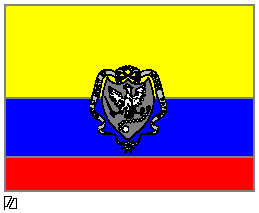
- Bandera Provisional de la Gran Colombia - 1821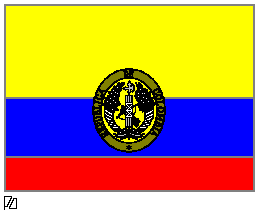
- Bandera de la Gran Colombia - 1822 / 1830
- Era Republicana (1830 en adelante)
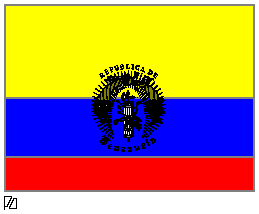
- Bandera Provisional de Venezuela, 1830

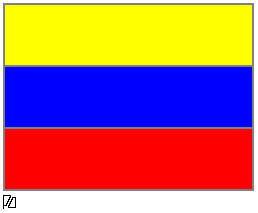
-Bandera de la República de Venezuela, 1836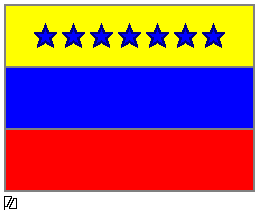
- Bandera de la Federación, Febrero 1859
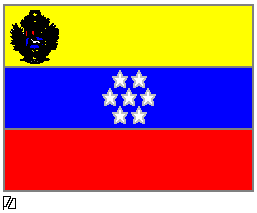
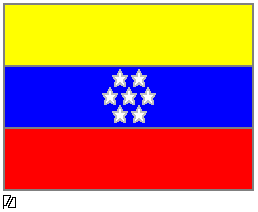
- Bandera de Venezuela, 1863
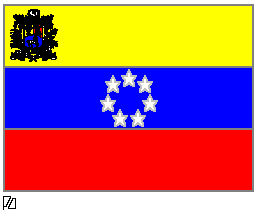
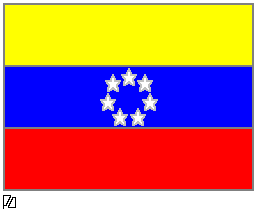
- Bandera de los Estados Unidos de Venezuela, 1905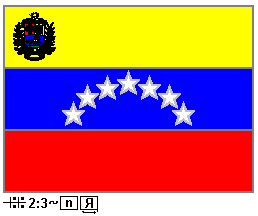
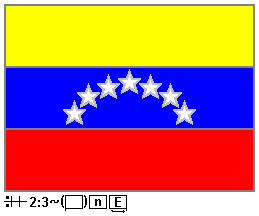

- Bandera Nacional de Venezuela, 1930
VEXILLOLOGICAL HISTORY OF VENEZUELA
By RAÚL JESÚS ORTA PARDO / Symbollogist
The Vexillological History of Venezuela could be divided into three stages:
- Colonial Age
- Independence Age
- Republican Age

- Standard of Catholic Kings - 1492
Consist in a white field charged with a green extended cross accompanied to
right and left sides by the abbreviations of so called "Reyes Católicos"
("Catholic Kings") Fernando and Isabel in the same color and crowned in
gold. It was one of the emblems that Columbus brought to America and it's
very probably that it was present when he sighted coasts of Peninsula de
Paria (at the moment, located to the East of Venezuela), as a part of his
Third Trip.

- Royal Standard of Carlos III (Charles III) in Caracas Municipality - 1725?
Consist in a swallow-tailed field vertically oriented with dark red
background charging Royal Coat of Arms on the superior part and the ones of
Caracas, repeated and confronted at the beginning of the tails, everything
enriched with a gilded fringe. The image is reconstruction of the original
piece that currently is exhibited on Caracas Museum of the Libertador
Municipality.

- Veteran Battalion of Caracas - 1790/1821?
Consist in a squared white field with Royal Coat of Arms superposed on the
center of Burgundy Cross of Burgundy joined with the Arms of Castile and
Leon with the ones of Caracas on the angles. The image is a reconstruction
made from a written source worthy of credit.

- Spanish Naval Standard - 1798
Consists of a field horizontal and unequal tierced whose superior and
inferior stripes are red and yellow the central with width equivalent to
the double of the previous ones: design decreed by king Carlos III (Charles
III) on 1785 and which is consolidated as Spanish National Flag in 1843. The
illustration is reconstruction of one of its evolutionary stages: in this
case, showing the Arms of Castile and Lion crowned and off-centered to the
hoist on the yellow stripe.
- Independence Age (1749 - 1830)

- Unknown Flag of Juan Francisco de Leon - 1749

- Project of Flag of
Juan Bautista Picornell -1797
Project of Flag of Gual y España - 1797
- Project of Flag of Francisco de Miranda - 1800

- Primate Flag of Venezuela - 1806
- Mother Flag - 1811

- Flag of the Liberator Army - 1811 / 1819
- Naval Ensign - May of 1817
- Flag decreed by Bolivar - October of 1817

- Provisional Flag of Great Colombia - 1821
- Flag of Great Colombia - 1822 / 1830
- Republican Age (1830 to present day)

- Provisional Flag of Venezuela, 1830


- Flag of Republic of Venezuela, 1836
- Flag of the Federation, February 1859
- Flag of the Federation, June 1859


- Flag of Venezuela, 1863

- Flag of the United States of Venezuela, 1905


- National Flag of Venezuela, 1930
VOLVER / BACK